Qantas Airlines Management Information System Report Analysis
VerifiedAdded on 2023/04/21
|25
|5406
|435
Report
AI Summary
This report presents a comprehensive analysis of a Management Information System (MIS) proposal for Qantas Airlines. The report begins with a letter to a sponsor, followed by an executive summary highlighting the benefits of implementing a process control system to reduce operational costs and manage crucial business information. It includes an overview of Qantas Airlines, its vision, mission, and an analysis of its external and internal environments using Porter's Five Forces, PESTLE, and SWOT frameworks. The report identifies problems and opportunities within Qantas's IS/IT infrastructure, justifying the selection of a process control system and providing a detailed cost/benefit analysis. It then outlines the System Development Life Cycle (SDLC) for the proposed MIS, including planning, analysis, design, development, testing, implementation, and maintenance phases. The report also addresses project, risk, and change management considerations, concluding with a summary of findings and recommendations for successful MIS implementation. The report is well-structured and provides valuable insights into the application of MIS in the airline industry.
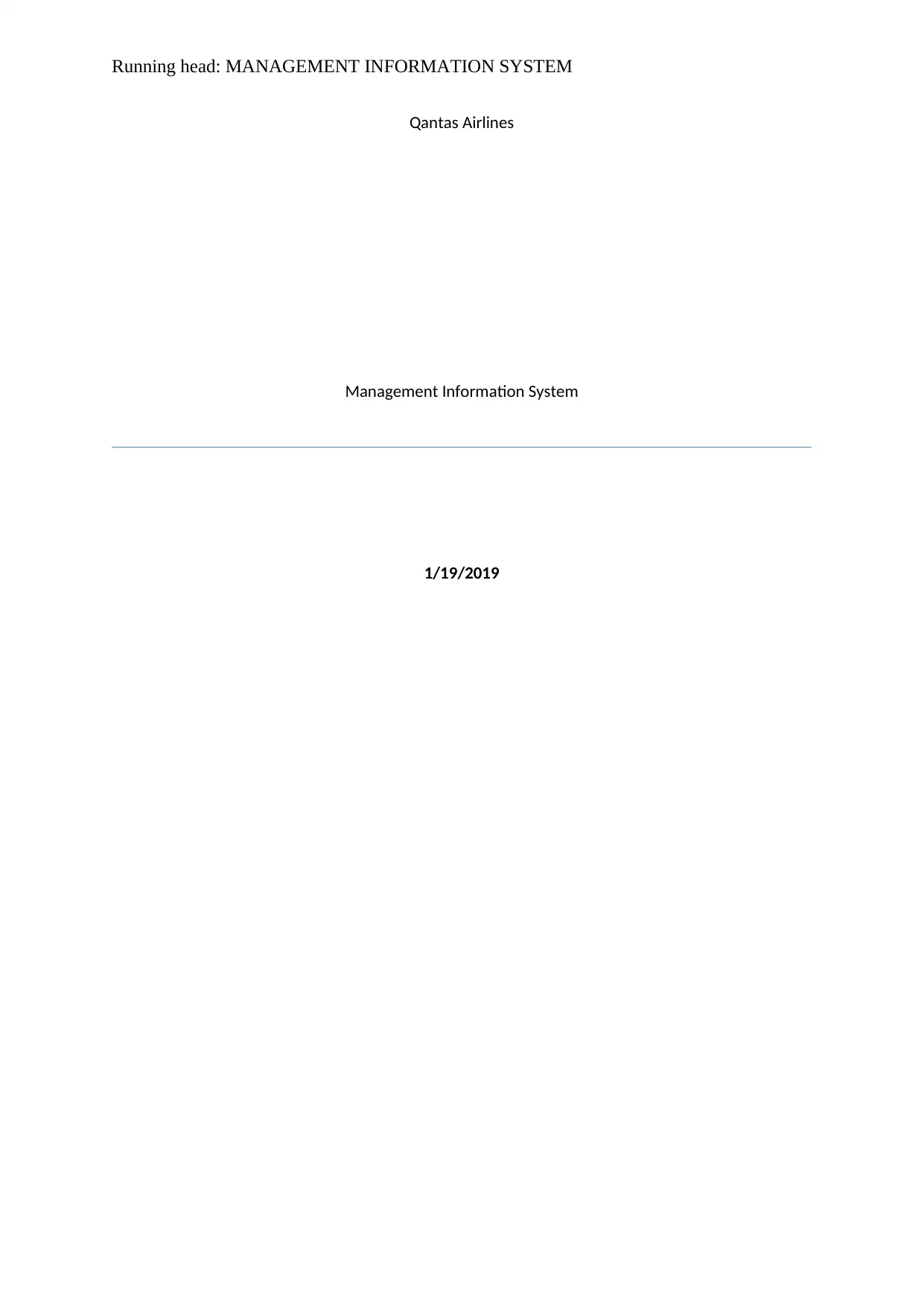
Running head: MANAGEMENT INFORMATION SYSTEM
Qantas Airlines
Management Information System
1/19/2019
Qantas Airlines
Management Information System
1/19/2019
Paraphrase This Document
Need a fresh take? Get an instant paraphrase of this document with our AI Paraphraser
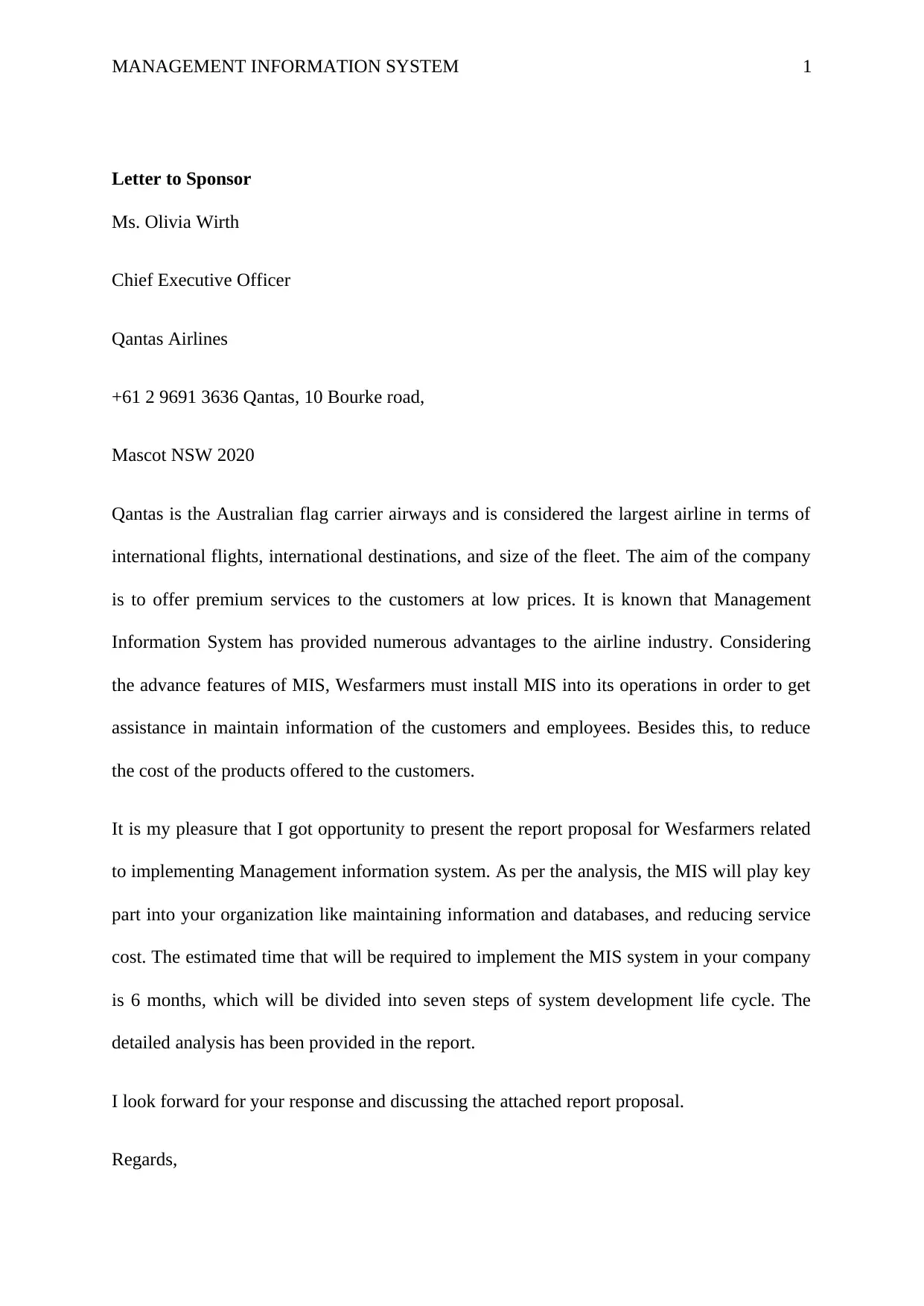
MANAGEMENT INFORMATION SYSTEM 1
Letter to Sponsor
Ms. Olivia Wirth
Chief Executive Officer
Qantas Airlines
+61 2 9691 3636 Qantas, 10 Bourke road,
Mascot NSW 2020
Qantas is the Australian flag carrier airways and is considered the largest airline in terms of
international flights, international destinations, and size of the fleet. The aim of the company
is to offer premium services to the customers at low prices. It is known that Management
Information System has provided numerous advantages to the airline industry. Considering
the advance features of MIS, Wesfarmers must install MIS into its operations in order to get
assistance in maintain information of the customers and employees. Besides this, to reduce
the cost of the products offered to the customers.
It is my pleasure that I got opportunity to present the report proposal for Wesfarmers related
to implementing Management information system. As per the analysis, the MIS will play key
part into your organization like maintaining information and databases, and reducing service
cost. The estimated time that will be required to implement the MIS system in your company
is 6 months, which will be divided into seven steps of system development life cycle. The
detailed analysis has been provided in the report.
I look forward for your response and discussing the attached report proposal.
Regards,
Letter to Sponsor
Ms. Olivia Wirth
Chief Executive Officer
Qantas Airlines
+61 2 9691 3636 Qantas, 10 Bourke road,
Mascot NSW 2020
Qantas is the Australian flag carrier airways and is considered the largest airline in terms of
international flights, international destinations, and size of the fleet. The aim of the company
is to offer premium services to the customers at low prices. It is known that Management
Information System has provided numerous advantages to the airline industry. Considering
the advance features of MIS, Wesfarmers must install MIS into its operations in order to get
assistance in maintain information of the customers and employees. Besides this, to reduce
the cost of the products offered to the customers.
It is my pleasure that I got opportunity to present the report proposal for Wesfarmers related
to implementing Management information system. As per the analysis, the MIS will play key
part into your organization like maintaining information and databases, and reducing service
cost. The estimated time that will be required to implement the MIS system in your company
is 6 months, which will be divided into seven steps of system development life cycle. The
detailed analysis has been provided in the report.
I look forward for your response and discussing the attached report proposal.
Regards,
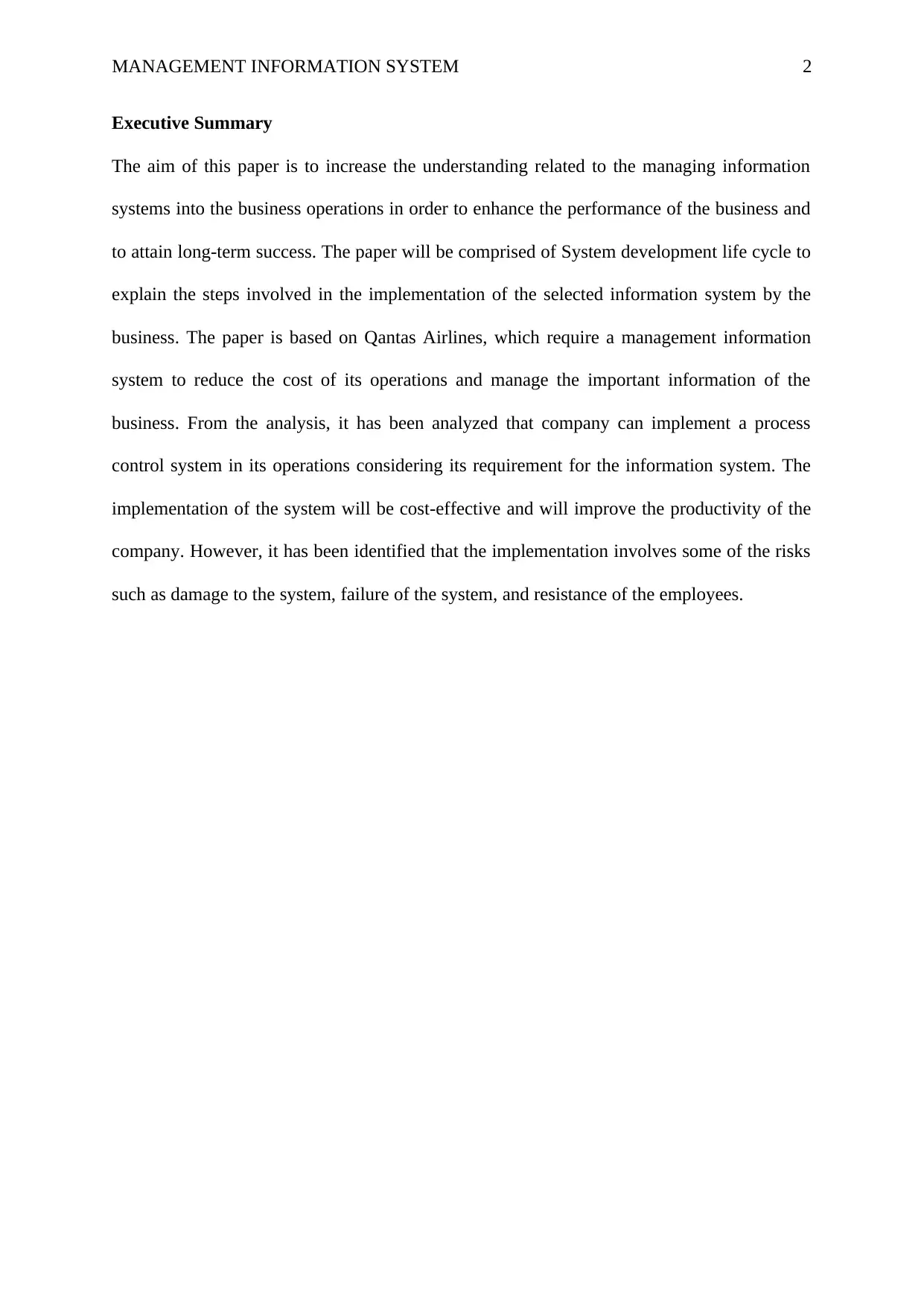
MANAGEMENT INFORMATION SYSTEM 2
Executive Summary
The aim of this paper is to increase the understanding related to the managing information
systems into the business operations in order to enhance the performance of the business and
to attain long-term success. The paper will be comprised of System development life cycle to
explain the steps involved in the implementation of the selected information system by the
business. The paper is based on Qantas Airlines, which require a management information
system to reduce the cost of its operations and manage the important information of the
business. From the analysis, it has been analyzed that company can implement a process
control system in its operations considering its requirement for the information system. The
implementation of the system will be cost-effective and will improve the productivity of the
company. However, it has been identified that the implementation involves some of the risks
such as damage to the system, failure of the system, and resistance of the employees.
Executive Summary
The aim of this paper is to increase the understanding related to the managing information
systems into the business operations in order to enhance the performance of the business and
to attain long-term success. The paper will be comprised of System development life cycle to
explain the steps involved in the implementation of the selected information system by the
business. The paper is based on Qantas Airlines, which require a management information
system to reduce the cost of its operations and manage the important information of the
business. From the analysis, it has been analyzed that company can implement a process
control system in its operations considering its requirement for the information system. The
implementation of the system will be cost-effective and will improve the productivity of the
company. However, it has been identified that the implementation involves some of the risks
such as damage to the system, failure of the system, and resistance of the employees.
⊘ This is a preview!⊘
Do you want full access?
Subscribe today to unlock all pages.

Trusted by 1+ million students worldwide
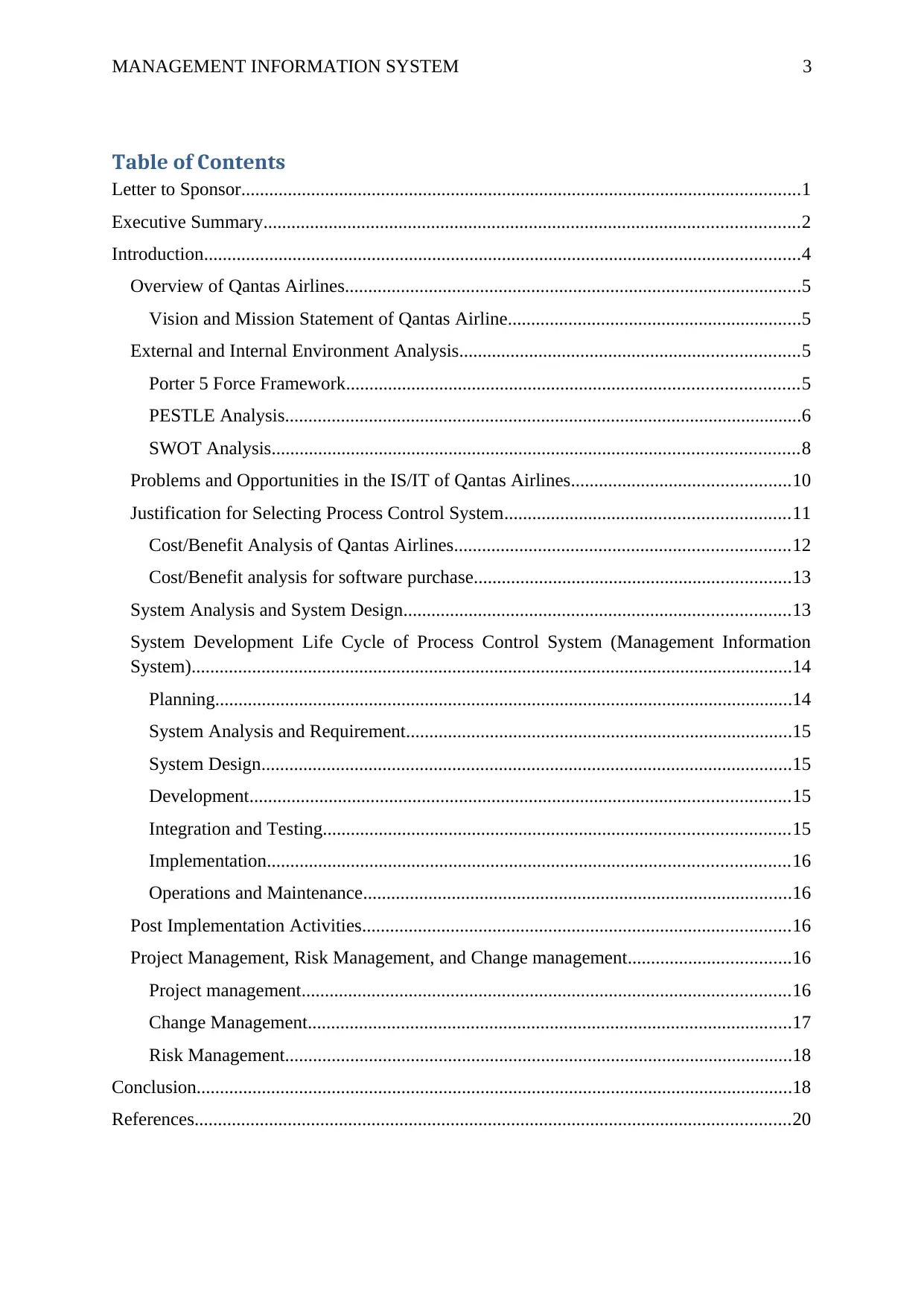
MANAGEMENT INFORMATION SYSTEM 3
Table of Contents
Letter to Sponsor........................................................................................................................1
Executive Summary...................................................................................................................2
Introduction................................................................................................................................4
Overview of Qantas Airlines..................................................................................................5
Vision and Mission Statement of Qantas Airline...............................................................5
External and Internal Environment Analysis.........................................................................5
Porter 5 Force Framework.................................................................................................5
PESTLE Analysis...............................................................................................................6
SWOT Analysis.................................................................................................................8
Problems and Opportunities in the IS/IT of Qantas Airlines...............................................10
Justification for Selecting Process Control System.............................................................11
Cost/Benefit Analysis of Qantas Airlines........................................................................12
Cost/Benefit analysis for software purchase....................................................................13
System Analysis and System Design...................................................................................13
System Development Life Cycle of Process Control System (Management Information
System).................................................................................................................................14
Planning............................................................................................................................14
System Analysis and Requirement...................................................................................15
System Design..................................................................................................................15
Development....................................................................................................................15
Integration and Testing....................................................................................................15
Implementation................................................................................................................16
Operations and Maintenance............................................................................................16
Post Implementation Activities............................................................................................16
Project Management, Risk Management, and Change management...................................16
Project management.........................................................................................................16
Change Management........................................................................................................17
Risk Management.............................................................................................................18
Conclusion................................................................................................................................18
References................................................................................................................................20
Table of Contents
Letter to Sponsor........................................................................................................................1
Executive Summary...................................................................................................................2
Introduction................................................................................................................................4
Overview of Qantas Airlines..................................................................................................5
Vision and Mission Statement of Qantas Airline...............................................................5
External and Internal Environment Analysis.........................................................................5
Porter 5 Force Framework.................................................................................................5
PESTLE Analysis...............................................................................................................6
SWOT Analysis.................................................................................................................8
Problems and Opportunities in the IS/IT of Qantas Airlines...............................................10
Justification for Selecting Process Control System.............................................................11
Cost/Benefit Analysis of Qantas Airlines........................................................................12
Cost/Benefit analysis for software purchase....................................................................13
System Analysis and System Design...................................................................................13
System Development Life Cycle of Process Control System (Management Information
System).................................................................................................................................14
Planning............................................................................................................................14
System Analysis and Requirement...................................................................................15
System Design..................................................................................................................15
Development....................................................................................................................15
Integration and Testing....................................................................................................15
Implementation................................................................................................................16
Operations and Maintenance............................................................................................16
Post Implementation Activities............................................................................................16
Project Management, Risk Management, and Change management...................................16
Project management.........................................................................................................16
Change Management........................................................................................................17
Risk Management.............................................................................................................18
Conclusion................................................................................................................................18
References................................................................................................................................20
Paraphrase This Document
Need a fresh take? Get an instant paraphrase of this document with our AI Paraphraser
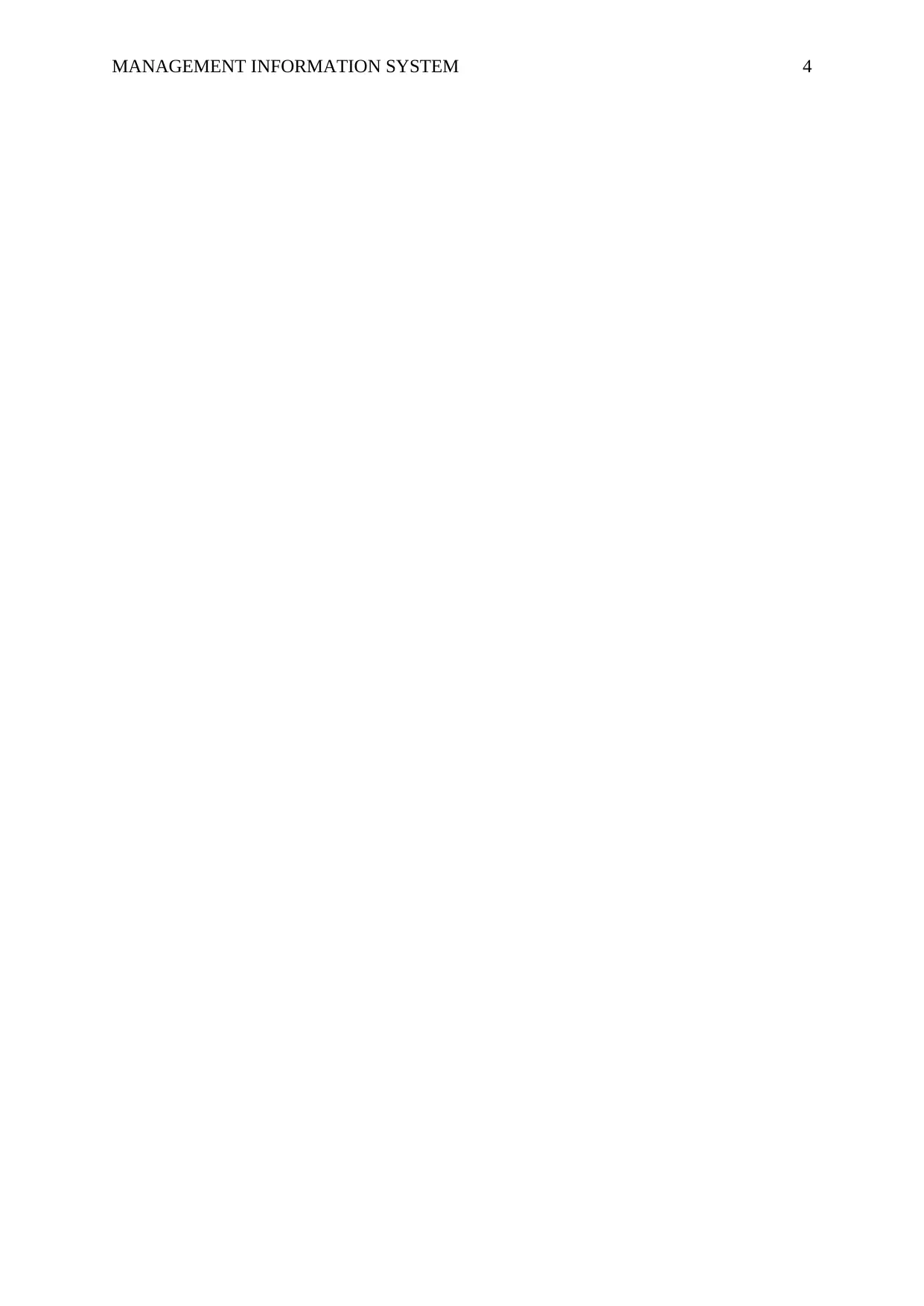
MANAGEMENT INFORMATION SYSTEM 4
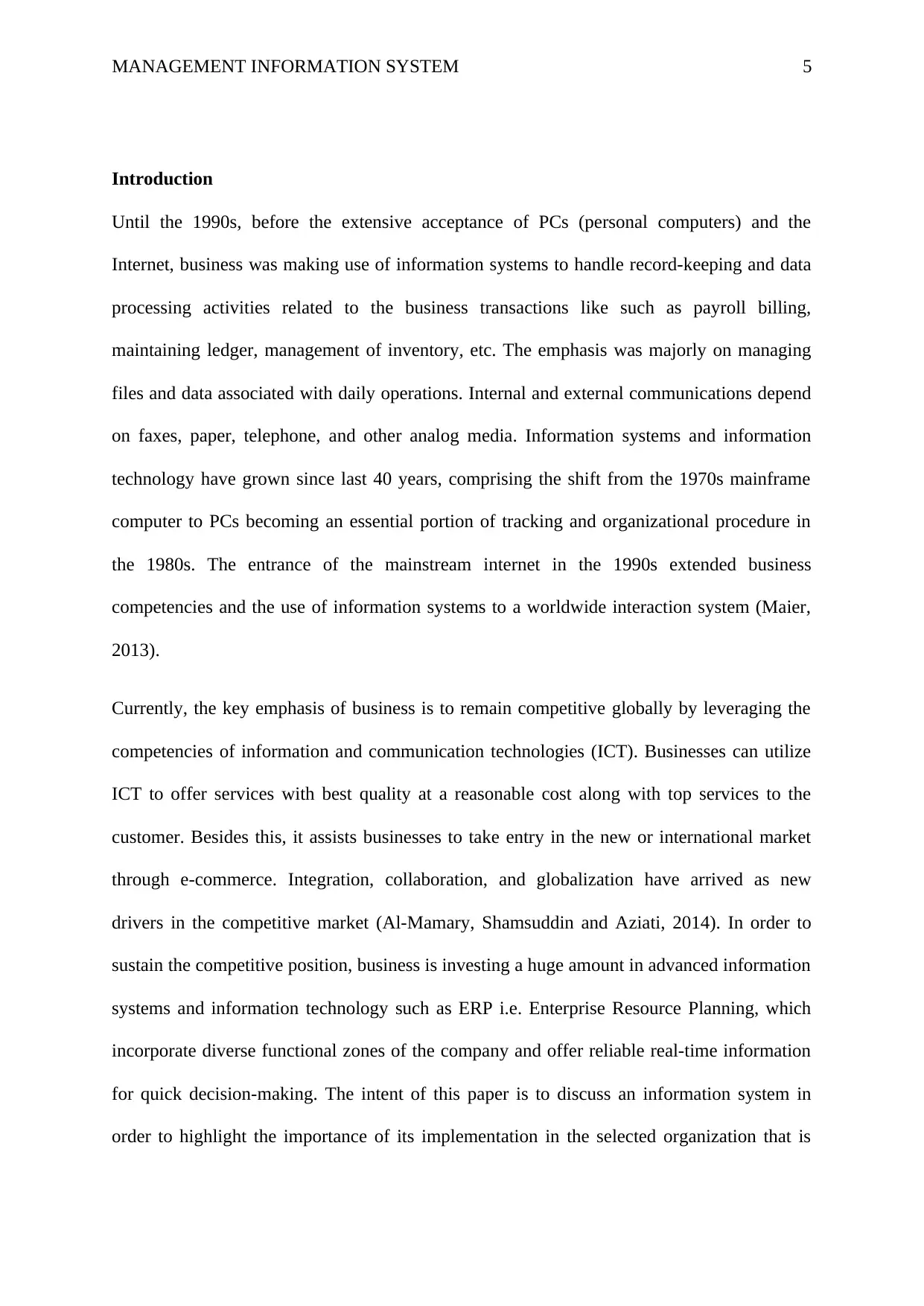
MANAGEMENT INFORMATION SYSTEM 5
Introduction
Until the 1990s, before the extensive acceptance of PCs (personal computers) and the
Internet, business was making use of information systems to handle record-keeping and data
processing activities related to the business transactions like such as payroll billing,
maintaining ledger, management of inventory, etc. The emphasis was majorly on managing
files and data associated with daily operations. Internal and external communications depend
on faxes, paper, telephone, and other analog media. Information systems and information
technology have grown since last 40 years, comprising the shift from the 1970s mainframe
computer to PCs becoming an essential portion of tracking and organizational procedure in
the 1980s. The entrance of the mainstream internet in the 1990s extended business
competencies and the use of information systems to a worldwide interaction system (Maier,
2013).
Currently, the key emphasis of business is to remain competitive globally by leveraging the
competencies of information and communication technologies (ICT). Businesses can utilize
ICT to offer services with best quality at a reasonable cost along with top services to the
customer. Besides this, it assists businesses to take entry in the new or international market
through e-commerce. Integration, collaboration, and globalization have arrived as new
drivers in the competitive market (Al-Mamary, Shamsuddin and Aziati, 2014). In order to
sustain the competitive position, business is investing a huge amount in advanced information
systems and information technology such as ERP i.e. Enterprise Resource Planning, which
incorporate diverse functional zones of the company and offer reliable real-time information
for quick decision-making. The intent of this paper is to discuss an information system in
order to highlight the importance of its implementation in the selected organization that is
Introduction
Until the 1990s, before the extensive acceptance of PCs (personal computers) and the
Internet, business was making use of information systems to handle record-keeping and data
processing activities related to the business transactions like such as payroll billing,
maintaining ledger, management of inventory, etc. The emphasis was majorly on managing
files and data associated with daily operations. Internal and external communications depend
on faxes, paper, telephone, and other analog media. Information systems and information
technology have grown since last 40 years, comprising the shift from the 1970s mainframe
computer to PCs becoming an essential portion of tracking and organizational procedure in
the 1980s. The entrance of the mainstream internet in the 1990s extended business
competencies and the use of information systems to a worldwide interaction system (Maier,
2013).
Currently, the key emphasis of business is to remain competitive globally by leveraging the
competencies of information and communication technologies (ICT). Businesses can utilize
ICT to offer services with best quality at a reasonable cost along with top services to the
customer. Besides this, it assists businesses to take entry in the new or international market
through e-commerce. Integration, collaboration, and globalization have arrived as new
drivers in the competitive market (Al-Mamary, Shamsuddin and Aziati, 2014). In order to
sustain the competitive position, business is investing a huge amount in advanced information
systems and information technology such as ERP i.e. Enterprise Resource Planning, which
incorporate diverse functional zones of the company and offer reliable real-time information
for quick decision-making. The intent of this paper is to discuss an information system in
order to highlight the importance of its implementation in the selected organization that is
⊘ This is a preview!⊘
Do you want full access?
Subscribe today to unlock all pages.

Trusted by 1+ million students worldwide
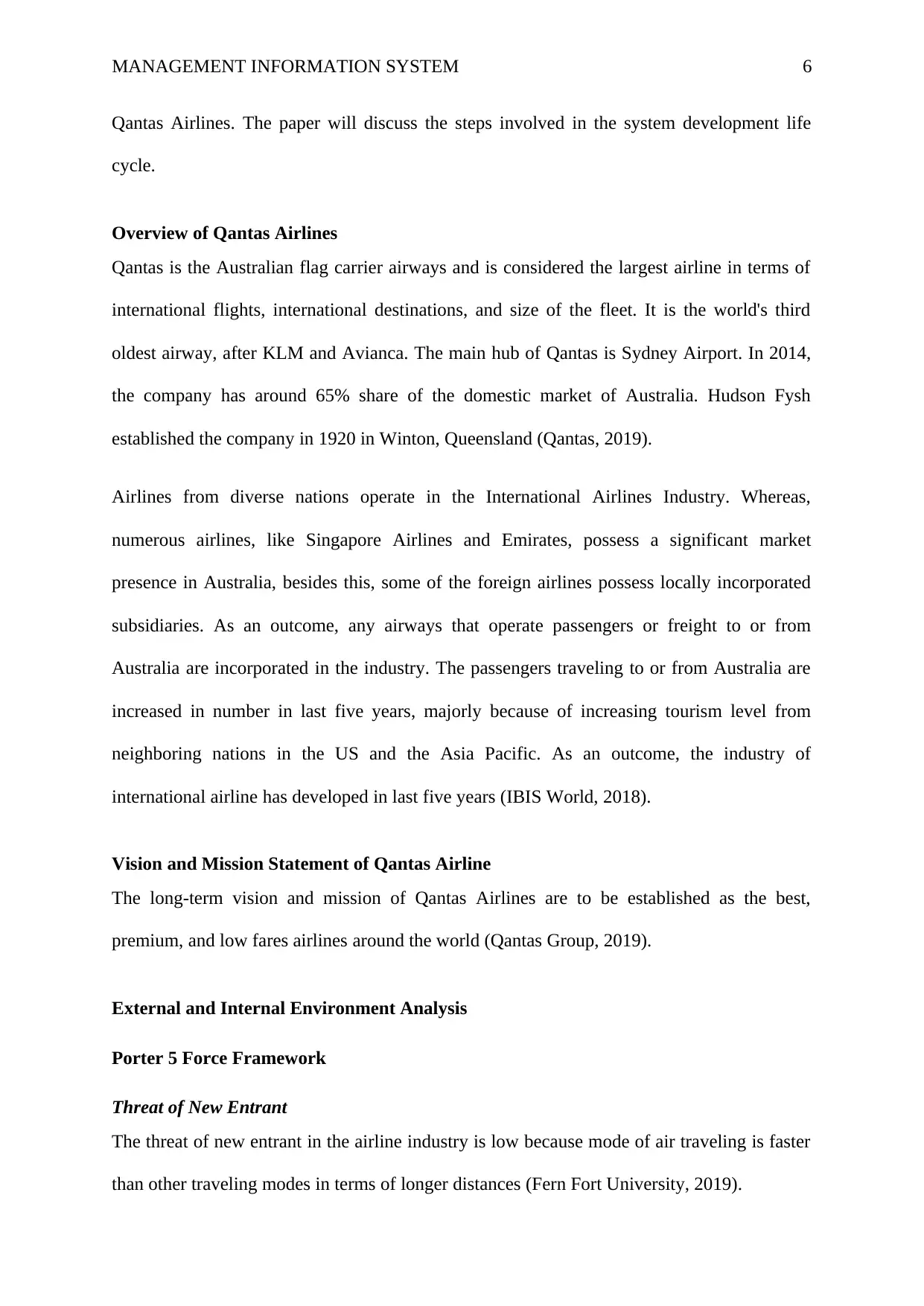
MANAGEMENT INFORMATION SYSTEM 6
Qantas Airlines. The paper will discuss the steps involved in the system development life
cycle.
Overview of Qantas Airlines
Qantas is the Australian flag carrier airways and is considered the largest airline in terms of
international flights, international destinations, and size of the fleet. It is the world's third
oldest airway, after KLM and Avianca. The main hub of Qantas is Sydney Airport. In 2014,
the company has around 65% share of the domestic market of Australia. Hudson Fysh
established the company in 1920 in Winton, Queensland (Qantas, 2019).
Airlines from diverse nations operate in the International Airlines Industry. Whereas,
numerous airlines, like Singapore Airlines and Emirates, possess a significant market
presence in Australia, besides this, some of the foreign airlines possess locally incorporated
subsidiaries. As an outcome, any airways that operate passengers or freight to or from
Australia are incorporated in the industry. The passengers traveling to or from Australia are
increased in number in last five years, majorly because of increasing tourism level from
neighboring nations in the US and the Asia Pacific. As an outcome, the industry of
international airline has developed in last five years (IBIS World, 2018).
Vision and Mission Statement of Qantas Airline
The long-term vision and mission of Qantas Airlines are to be established as the best,
premium, and low fares airlines around the world (Qantas Group, 2019).
External and Internal Environment Analysis
Porter 5 Force Framework
Threat of New Entrant
The threat of new entrant in the airline industry is low because mode of air traveling is faster
than other traveling modes in terms of longer distances (Fern Fort University, 2019).
Qantas Airlines. The paper will discuss the steps involved in the system development life
cycle.
Overview of Qantas Airlines
Qantas is the Australian flag carrier airways and is considered the largest airline in terms of
international flights, international destinations, and size of the fleet. It is the world's third
oldest airway, after KLM and Avianca. The main hub of Qantas is Sydney Airport. In 2014,
the company has around 65% share of the domestic market of Australia. Hudson Fysh
established the company in 1920 in Winton, Queensland (Qantas, 2019).
Airlines from diverse nations operate in the International Airlines Industry. Whereas,
numerous airlines, like Singapore Airlines and Emirates, possess a significant market
presence in Australia, besides this, some of the foreign airlines possess locally incorporated
subsidiaries. As an outcome, any airways that operate passengers or freight to or from
Australia are incorporated in the industry. The passengers traveling to or from Australia are
increased in number in last five years, majorly because of increasing tourism level from
neighboring nations in the US and the Asia Pacific. As an outcome, the industry of
international airline has developed in last five years (IBIS World, 2018).
Vision and Mission Statement of Qantas Airline
The long-term vision and mission of Qantas Airlines are to be established as the best,
premium, and low fares airlines around the world (Qantas Group, 2019).
External and Internal Environment Analysis
Porter 5 Force Framework
Threat of New Entrant
The threat of new entrant in the airline industry is low because mode of air traveling is faster
than other traveling modes in terms of longer distances (Fern Fort University, 2019).
Paraphrase This Document
Need a fresh take? Get an instant paraphrase of this document with our AI Paraphraser
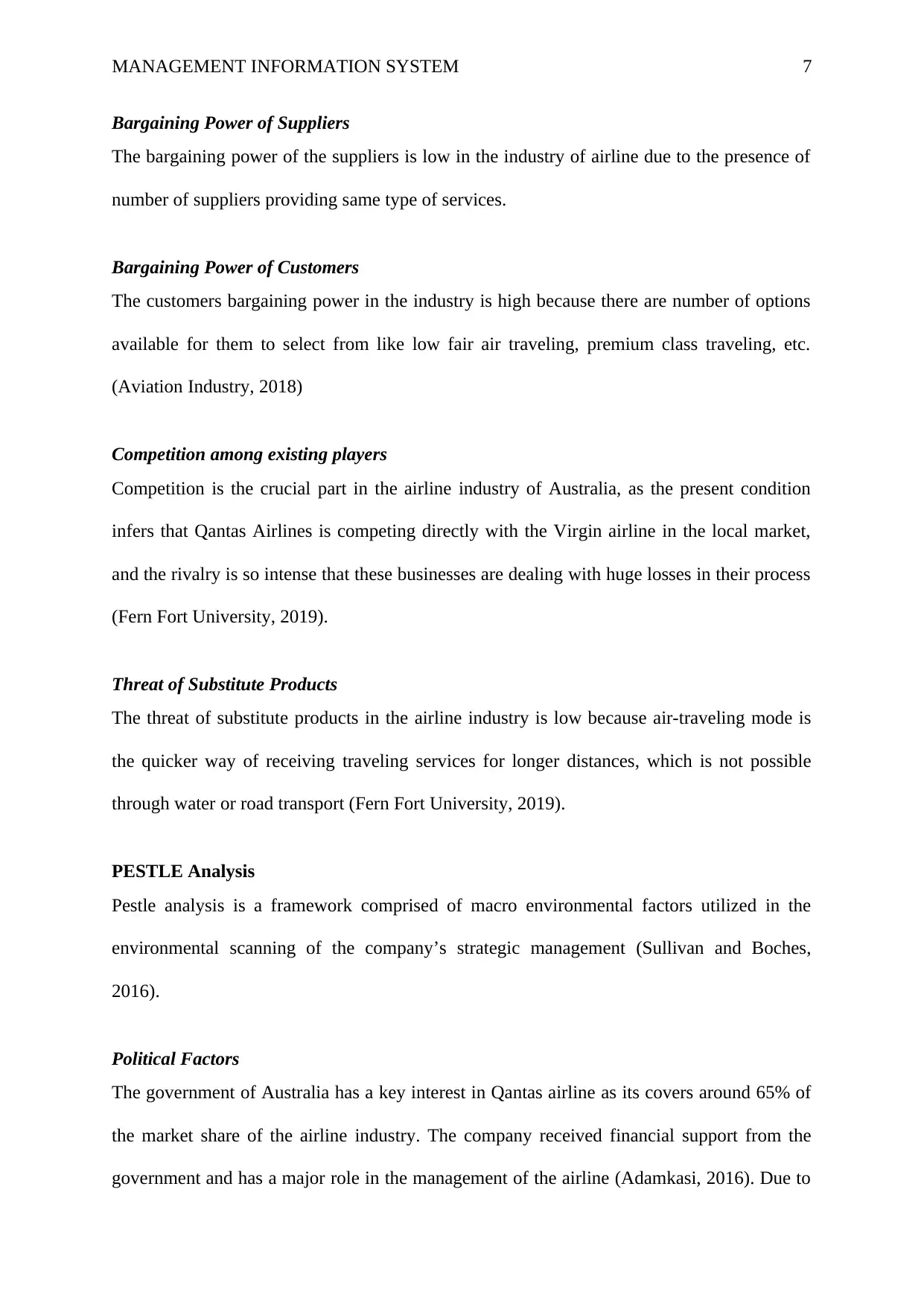
MANAGEMENT INFORMATION SYSTEM 7
Bargaining Power of Suppliers
The bargaining power of the suppliers is low in the industry of airline due to the presence of
number of suppliers providing same type of services.
Bargaining Power of Customers
The customers bargaining power in the industry is high because there are number of options
available for them to select from like low fair air traveling, premium class traveling, etc.
(Aviation Industry, 2018)
Competition among existing players
Competition is the crucial part in the airline industry of Australia, as the present condition
infers that Qantas Airlines is competing directly with the Virgin airline in the local market,
and the rivalry is so intense that these businesses are dealing with huge losses in their process
(Fern Fort University, 2019).
Threat of Substitute Products
The threat of substitute products in the airline industry is low because air-traveling mode is
the quicker way of receiving traveling services for longer distances, which is not possible
through water or road transport (Fern Fort University, 2019).
PESTLE Analysis
Pestle analysis is a framework comprised of macro environmental factors utilized in the
environmental scanning of the company’s strategic management (Sullivan and Boches,
2016).
Political Factors
The government of Australia has a key interest in Qantas airline as its covers around 65% of
the market share of the airline industry. The company received financial support from the
government and has a major role in the management of the airline (Adamkasi, 2016). Due to
Bargaining Power of Suppliers
The bargaining power of the suppliers is low in the industry of airline due to the presence of
number of suppliers providing same type of services.
Bargaining Power of Customers
The customers bargaining power in the industry is high because there are number of options
available for them to select from like low fair air traveling, premium class traveling, etc.
(Aviation Industry, 2018)
Competition among existing players
Competition is the crucial part in the airline industry of Australia, as the present condition
infers that Qantas Airlines is competing directly with the Virgin airline in the local market,
and the rivalry is so intense that these businesses are dealing with huge losses in their process
(Fern Fort University, 2019).
Threat of Substitute Products
The threat of substitute products in the airline industry is low because air-traveling mode is
the quicker way of receiving traveling services for longer distances, which is not possible
through water or road transport (Fern Fort University, 2019).
PESTLE Analysis
Pestle analysis is a framework comprised of macro environmental factors utilized in the
environmental scanning of the company’s strategic management (Sullivan and Boches,
2016).
Political Factors
The government of Australia has a key interest in Qantas airline as its covers around 65% of
the market share of the airline industry. The company received financial support from the
government and has a major role in the management of the airline (Adamkasi, 2016). Due to
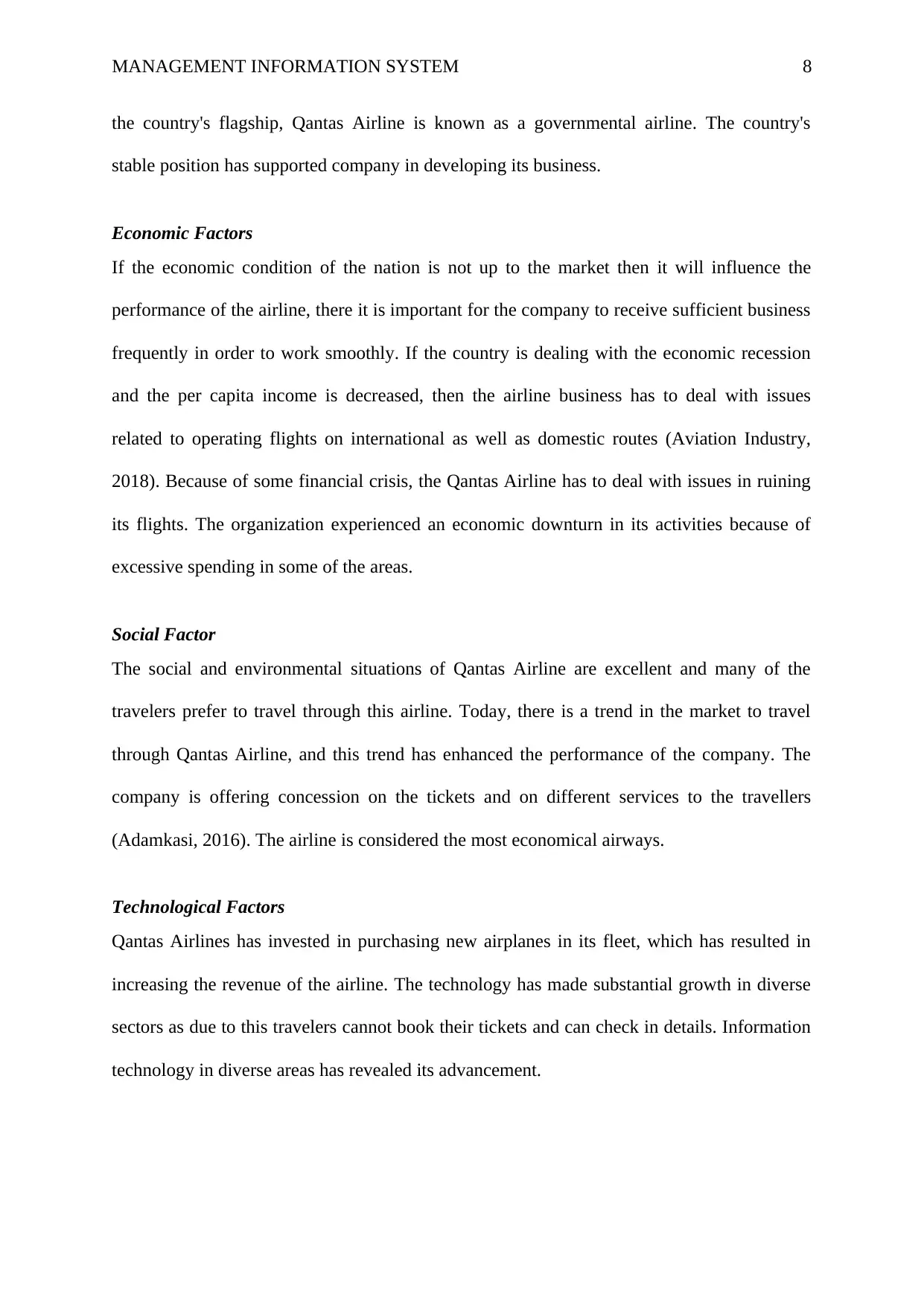
MANAGEMENT INFORMATION SYSTEM 8
the country's flagship, Qantas Airline is known as a governmental airline. The country's
stable position has supported company in developing its business.
Economic Factors
If the economic condition of the nation is not up to the market then it will influence the
performance of the airline, there it is important for the company to receive sufficient business
frequently in order to work smoothly. If the country is dealing with the economic recession
and the per capita income is decreased, then the airline business has to deal with issues
related to operating flights on international as well as domestic routes (Aviation Industry,
2018). Because of some financial crisis, the Qantas Airline has to deal with issues in ruining
its flights. The organization experienced an economic downturn in its activities because of
excessive spending in some of the areas.
Social Factor
The social and environmental situations of Qantas Airline are excellent and many of the
travelers prefer to travel through this airline. Today, there is a trend in the market to travel
through Qantas Airline, and this trend has enhanced the performance of the company. The
company is offering concession on the tickets and on different services to the travellers
(Adamkasi, 2016). The airline is considered the most economical airways.
Technological Factors
Qantas Airlines has invested in purchasing new airplanes in its fleet, which has resulted in
increasing the revenue of the airline. The technology has made substantial growth in diverse
sectors as due to this travelers cannot book their tickets and can check in details. Information
technology in diverse areas has revealed its advancement.
the country's flagship, Qantas Airline is known as a governmental airline. The country's
stable position has supported company in developing its business.
Economic Factors
If the economic condition of the nation is not up to the market then it will influence the
performance of the airline, there it is important for the company to receive sufficient business
frequently in order to work smoothly. If the country is dealing with the economic recession
and the per capita income is decreased, then the airline business has to deal with issues
related to operating flights on international as well as domestic routes (Aviation Industry,
2018). Because of some financial crisis, the Qantas Airline has to deal with issues in ruining
its flights. The organization experienced an economic downturn in its activities because of
excessive spending in some of the areas.
Social Factor
The social and environmental situations of Qantas Airline are excellent and many of the
travelers prefer to travel through this airline. Today, there is a trend in the market to travel
through Qantas Airline, and this trend has enhanced the performance of the company. The
company is offering concession on the tickets and on different services to the travellers
(Adamkasi, 2016). The airline is considered the most economical airways.
Technological Factors
Qantas Airlines has invested in purchasing new airplanes in its fleet, which has resulted in
increasing the revenue of the airline. The technology has made substantial growth in diverse
sectors as due to this travelers cannot book their tickets and can check in details. Information
technology in diverse areas has revealed its advancement.
⊘ This is a preview!⊘
Do you want full access?
Subscribe today to unlock all pages.

Trusted by 1+ million students worldwide
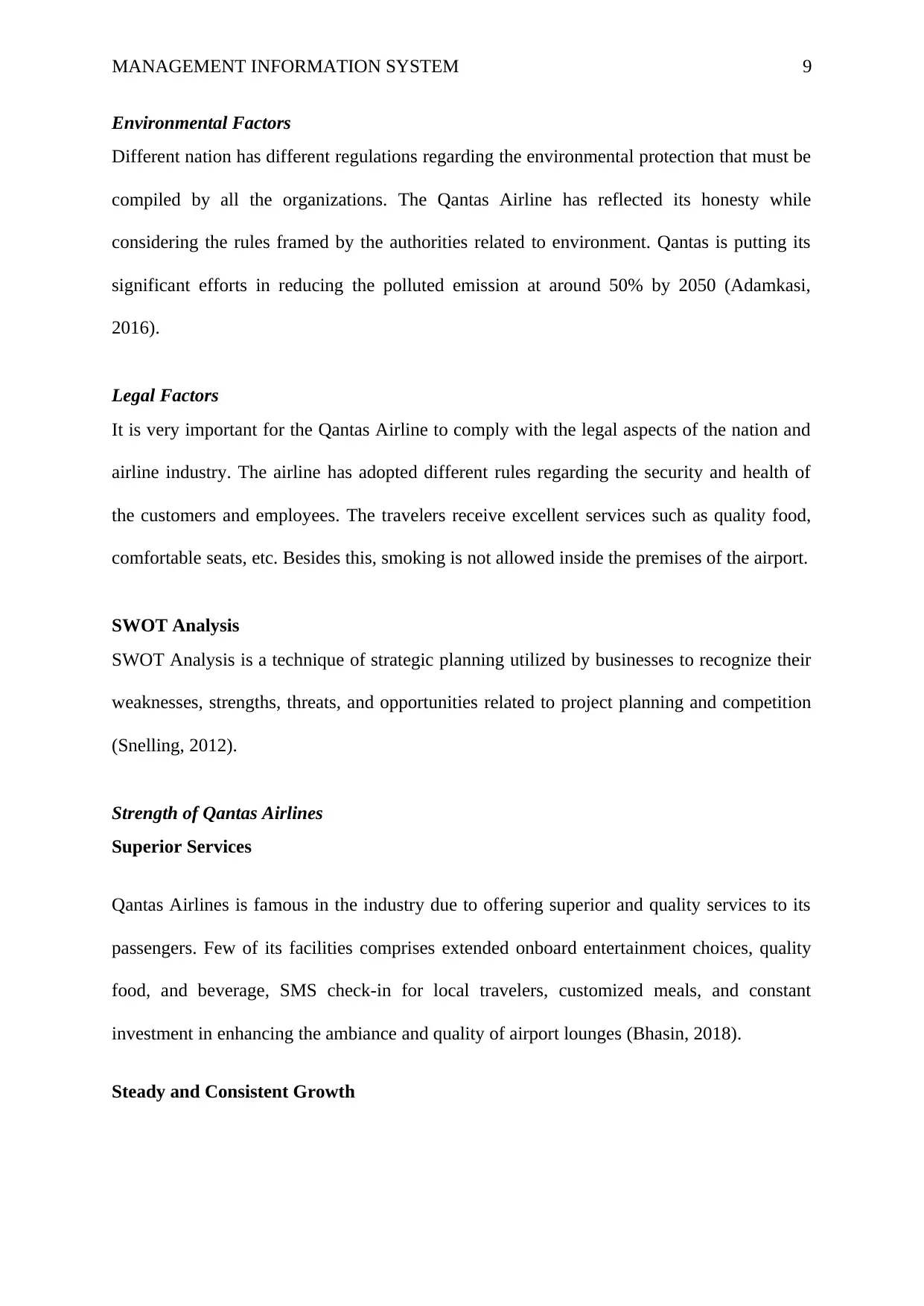
MANAGEMENT INFORMATION SYSTEM 9
Environmental Factors
Different nation has different regulations regarding the environmental protection that must be
compiled by all the organizations. The Qantas Airline has reflected its honesty while
considering the rules framed by the authorities related to environment. Qantas is putting its
significant efforts in reducing the polluted emission at around 50% by 2050 (Adamkasi,
2016).
Legal Factors
It is very important for the Qantas Airline to comply with the legal aspects of the nation and
airline industry. The airline has adopted different rules regarding the security and health of
the customers and employees. The travelers receive excellent services such as quality food,
comfortable seats, etc. Besides this, smoking is not allowed inside the premises of the airport.
SWOT Analysis
SWOT Analysis is a technique of strategic planning utilized by businesses to recognize their
weaknesses, strengths, threats, and opportunities related to project planning and competition
(Snelling, 2012).
Strength of Qantas Airlines
Superior Services
Qantas Airlines is famous in the industry due to offering superior and quality services to its
passengers. Few of its facilities comprises extended onboard entertainment choices, quality
food, and beverage, SMS check-in for local travelers, customized meals, and constant
investment in enhancing the ambiance and quality of airport lounges (Bhasin, 2018).
Steady and Consistent Growth
Environmental Factors
Different nation has different regulations regarding the environmental protection that must be
compiled by all the organizations. The Qantas Airline has reflected its honesty while
considering the rules framed by the authorities related to environment. Qantas is putting its
significant efforts in reducing the polluted emission at around 50% by 2050 (Adamkasi,
2016).
Legal Factors
It is very important for the Qantas Airline to comply with the legal aspects of the nation and
airline industry. The airline has adopted different rules regarding the security and health of
the customers and employees. The travelers receive excellent services such as quality food,
comfortable seats, etc. Besides this, smoking is not allowed inside the premises of the airport.
SWOT Analysis
SWOT Analysis is a technique of strategic planning utilized by businesses to recognize their
weaknesses, strengths, threats, and opportunities related to project planning and competition
(Snelling, 2012).
Strength of Qantas Airlines
Superior Services
Qantas Airlines is famous in the industry due to offering superior and quality services to its
passengers. Few of its facilities comprises extended onboard entertainment choices, quality
food, and beverage, SMS check-in for local travelers, customized meals, and constant
investment in enhancing the ambiance and quality of airport lounges (Bhasin, 2018).
Steady and Consistent Growth
Paraphrase This Document
Need a fresh take? Get an instant paraphrase of this document with our AI Paraphraser
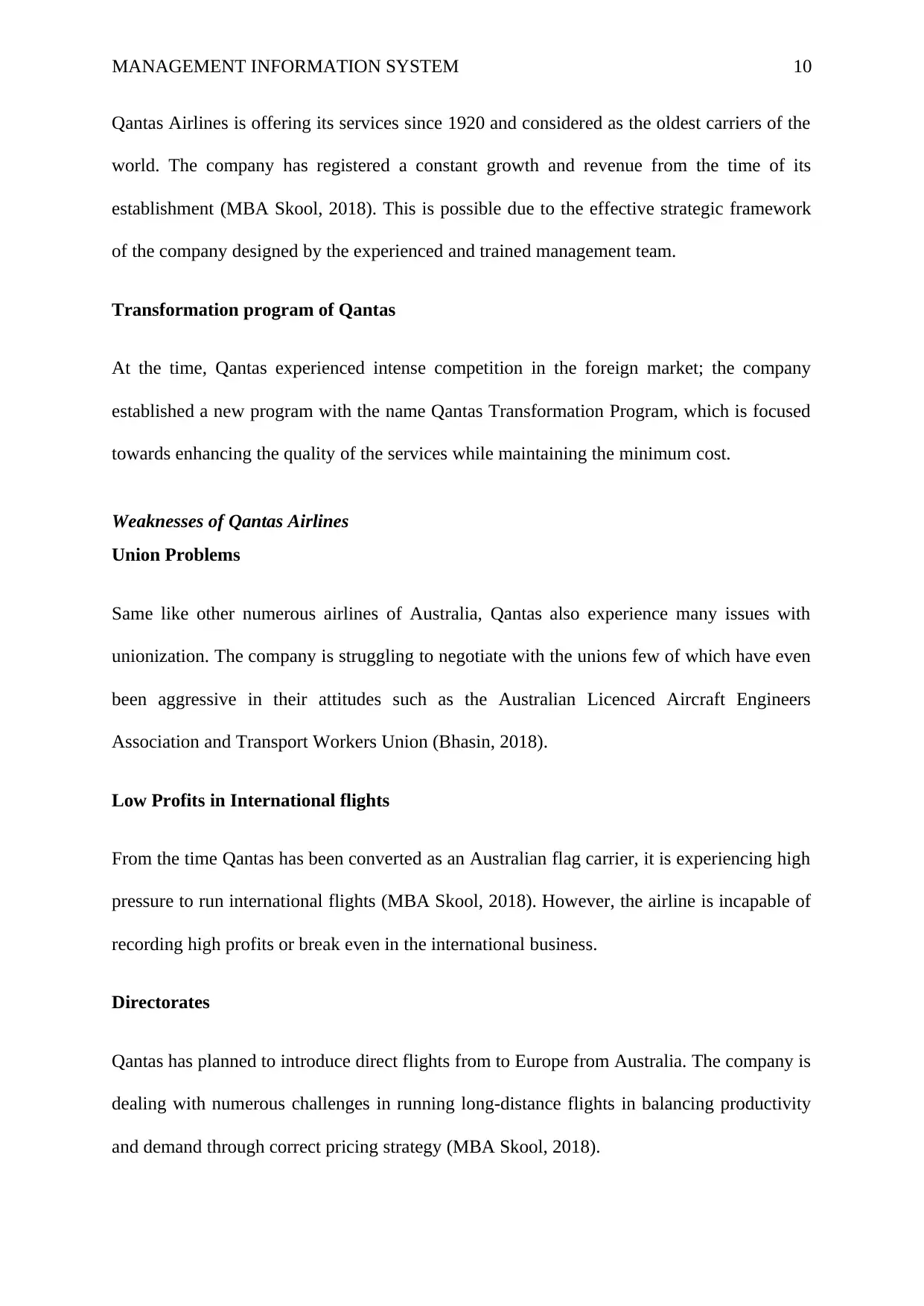
MANAGEMENT INFORMATION SYSTEM 10
Qantas Airlines is offering its services since 1920 and considered as the oldest carriers of the
world. The company has registered a constant growth and revenue from the time of its
establishment (MBA Skool, 2018). This is possible due to the effective strategic framework
of the company designed by the experienced and trained management team.
Transformation program of Qantas
At the time, Qantas experienced intense competition in the foreign market; the company
established a new program with the name Qantas Transformation Program, which is focused
towards enhancing the quality of the services while maintaining the minimum cost.
Weaknesses of Qantas Airlines
Union Problems
Same like other numerous airlines of Australia, Qantas also experience many issues with
unionization. The company is struggling to negotiate with the unions few of which have even
been aggressive in their attitudes such as the Australian Licenced Aircraft Engineers
Association and Transport Workers Union (Bhasin, 2018).
Low Profits in International flights
From the time Qantas has been converted as an Australian flag carrier, it is experiencing high
pressure to run international flights (MBA Skool, 2018). However, the airline is incapable of
recording high profits or break even in the international business.
Directorates
Qantas has planned to introduce direct flights from to Europe from Australia. The company is
dealing with numerous challenges in running long-distance flights in balancing productivity
and demand through correct pricing strategy (MBA Skool, 2018).
Qantas Airlines is offering its services since 1920 and considered as the oldest carriers of the
world. The company has registered a constant growth and revenue from the time of its
establishment (MBA Skool, 2018). This is possible due to the effective strategic framework
of the company designed by the experienced and trained management team.
Transformation program of Qantas
At the time, Qantas experienced intense competition in the foreign market; the company
established a new program with the name Qantas Transformation Program, which is focused
towards enhancing the quality of the services while maintaining the minimum cost.
Weaknesses of Qantas Airlines
Union Problems
Same like other numerous airlines of Australia, Qantas also experience many issues with
unionization. The company is struggling to negotiate with the unions few of which have even
been aggressive in their attitudes such as the Australian Licenced Aircraft Engineers
Association and Transport Workers Union (Bhasin, 2018).
Low Profits in International flights
From the time Qantas has been converted as an Australian flag carrier, it is experiencing high
pressure to run international flights (MBA Skool, 2018). However, the airline is incapable of
recording high profits or break even in the international business.
Directorates
Qantas has planned to introduce direct flights from to Europe from Australia. The company is
dealing with numerous challenges in running long-distance flights in balancing productivity
and demand through correct pricing strategy (MBA Skool, 2018).
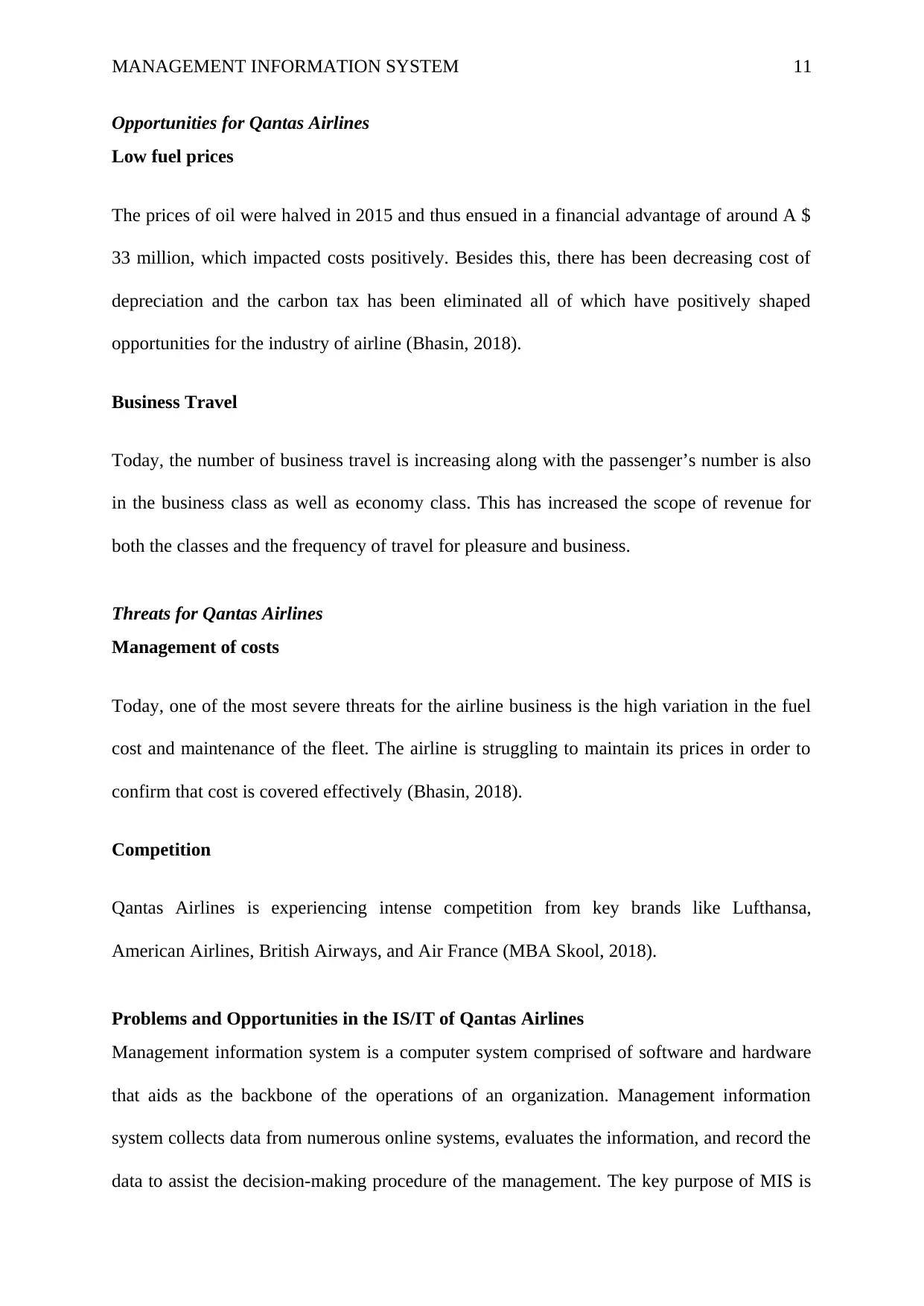
MANAGEMENT INFORMATION SYSTEM 11
Opportunities for Qantas Airlines
Low fuel prices
The prices of oil were halved in 2015 and thus ensued in a financial advantage of around A $
33 million, which impacted costs positively. Besides this, there has been decreasing cost of
depreciation and the carbon tax has been eliminated all of which have positively shaped
opportunities for the industry of airline (Bhasin, 2018).
Business Travel
Today, the number of business travel is increasing along with the passenger’s number is also
in the business class as well as economy class. This has increased the scope of revenue for
both the classes and the frequency of travel for pleasure and business.
Threats for Qantas Airlines
Management of costs
Today, one of the most severe threats for the airline business is the high variation in the fuel
cost and maintenance of the fleet. The airline is struggling to maintain its prices in order to
confirm that cost is covered effectively (Bhasin, 2018).
Competition
Qantas Airlines is experiencing intense competition from key brands like Lufthansa,
American Airlines, British Airways, and Air France (MBA Skool, 2018).
Problems and Opportunities in the IS/IT of Qantas Airlines
Management information system is a computer system comprised of software and hardware
that aids as the backbone of the operations of an organization. Management information
system collects data from numerous online systems, evaluates the information, and record the
data to assist the decision-making procedure of the management. The key purpose of MIS is
Opportunities for Qantas Airlines
Low fuel prices
The prices of oil were halved in 2015 and thus ensued in a financial advantage of around A $
33 million, which impacted costs positively. Besides this, there has been decreasing cost of
depreciation and the carbon tax has been eliminated all of which have positively shaped
opportunities for the industry of airline (Bhasin, 2018).
Business Travel
Today, the number of business travel is increasing along with the passenger’s number is also
in the business class as well as economy class. This has increased the scope of revenue for
both the classes and the frequency of travel for pleasure and business.
Threats for Qantas Airlines
Management of costs
Today, one of the most severe threats for the airline business is the high variation in the fuel
cost and maintenance of the fleet. The airline is struggling to maintain its prices in order to
confirm that cost is covered effectively (Bhasin, 2018).
Competition
Qantas Airlines is experiencing intense competition from key brands like Lufthansa,
American Airlines, British Airways, and Air France (MBA Skool, 2018).
Problems and Opportunities in the IS/IT of Qantas Airlines
Management information system is a computer system comprised of software and hardware
that aids as the backbone of the operations of an organization. Management information
system collects data from numerous online systems, evaluates the information, and record the
data to assist the decision-making procedure of the management. The key purpose of MIS is
⊘ This is a preview!⊘
Do you want full access?
Subscribe today to unlock all pages.

Trusted by 1+ million students worldwide
1 out of 25
Related Documents
Your All-in-One AI-Powered Toolkit for Academic Success.
+13062052269
info@desklib.com
Available 24*7 on WhatsApp / Email
![[object Object]](/_next/static/media/star-bottom.7253800d.svg)
Unlock your academic potential
Copyright © 2020–2025 A2Z Services. All Rights Reserved. Developed and managed by ZUCOL.





